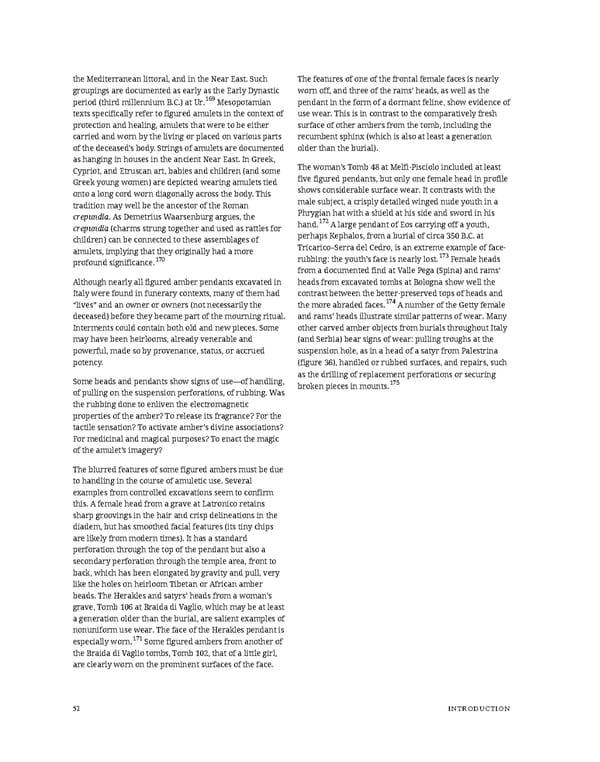the Mediterranean littoral, and in the Near East. Such The features of one of the frontal female faces is nearly groupings are documented as early as the Early Dynastic worn off, and three of the rams’ heads, as well as the period (third millennium B.C.) at Ur.169 Mesopotamian pendant in the form of a dormant feline, show evidence of texts specifically refer to figured amulets in the context of use wear. This is in contrast to the comparatively fresh protection and healing, amulets that were to be either surface of other ambers from the tomb, including the carried and worn by the living or placed on various parts recumbent sphinx (which is also at least a generation of the deceased’s body. Strings of amulets are documented older than the burial). as hanging in houses in the ancient Near East. In Greek, Cypriot, and Etruscan art, babies and children (and some The woman’s Tomb 48 at Melfi-Pisciolo included at least Greek young women) are depicted wearing amulets tied five figured pendants, but only one female head in profile onto a long cord worn diagonally across the body. This shows considerable surface wear. It contrasts with the tradition may well be the ancestor of the Roman male subject, a crisply detailed winged nude youth in a crepundia. As Demetrius Waarsenburg argues, the Phrygian hat with a shield at his side and sword in his hand.172 A large pendant of Eos carrying off a youth, crepundia (charms strung together and used as rattles for children) can be connected to these assemblages of perhaps Kephalos, from a burial of circa 350 B.C. at amulets, implying that they originally had a more Tricarico–Serra del Cedro, is an extreme example of face- 170 rubbing: the youth’s face is nearly lost.173 Female heads profound significance. from a documented find at Valle Pega (Spina) and rams’ Although nearly all figured amber pendants excavated in heads from excavated tombs at Bologna show well the Italy were found in funerary contexts, many of them had contrast between the better-preserved tops of heads and “lives” and an owner or owners (not necessarily the the more abraded faces.174 A number of the Getty female deceased) before they became part of the mourning ritual. and rams’ heads illustrate similar patterns of wear. Many Interments could contain both old and new pieces. Some other carved amber objects from burials throughout Italy may have been heirlooms, already venerable and (and Serbia) bear signs of wear: pulling troughs at the powerful, made so by provenance, status, or accrued suspension hole, as in a head of a satyr from Palestrina potency. (figure 36), handled or rubbed surfaces, and repairs, such Some beads and pendants show signs of use—of handling, as the drilling of replacement perforations or securing broken pieces in mounts.175 of pulling on the suspension perforations, of rubbing. Was the rubbing done to enliven the electromagnetic properties of the amber? To release its fragrance? For the tactile sensation? To activate amber’s divine associations? For medicinal and magical purposes? To enact the magic of the amulet’s imagery? The blurred features of some figured ambers must be due to handling in the course of amuletic use. Several examples from controlled excavations seem to confirm this. A female head from a grave at Latronico retains sharp groovings in the hair and crisp delineations in the diadem, but has smoothed facial features (its tiny chips are likely from modern times). It has a standard perforation through the top of the pendant but also a secondary perforation through the temple area, front to back, which has been elongated by gravity and pull, very like the holes on heirloom Tibetan or African amber beads. The Herakles and satyrs’ heads from a woman’s grave, Tomb 106 at Braida di Vaglio, which may be at least a generation older than the burial, are salient examples of nonuniform use wear. The face of the Herakles pendant is especially worn.171 Some figured ambers from another of the Braida di Vaglio tombs, Tomb 102, that of a little girl, are clearly worn on the prominent surfaces of the face. 52 INTRODUCTION
 Ancient Carved Ambers in the J. Paul Getty Museum Page 61 Page 63
Ancient Carved Ambers in the J. Paul Getty Museum Page 61 Page 63